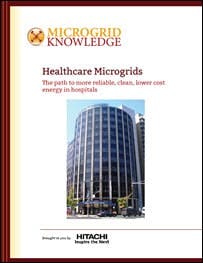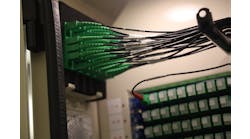This is second article in a series that looks at how healthcare microgrids open the door to more reliable, clean, lower cost energy in hospitals, and more resilient communities.
Society has grown increasingly aware of the electric grid’s vulnerabilities. And with that awareness has come investigation into technologies that can protect our critical infrastructure when widespread power outages occur. Microgrids are part of the ‘new wave’ among these resilient technologies.
Download the full report now
Sensitive to the threat of severe weather and cyberattacks on the electric grid, several states have funded programs to build what are known as community or resiliency microgrids.
Power outages caused by severe weather cost the US economy between $18 billion to $33 billion annually, according to a federal report that studied the years 2003 to 2012.
Sensitive to the threat of severe weather and cyberattacks on the electric grid, several states have funded programs to build what are known as community or resiliency microgrids. Often funding for these microgrids is contingent upon them serving hospitals, police stations, water treatment facilities, telecommunication towers and other crucial infrastructure.
Considered a microgrid leader, New York state offers a good example. The state’s clean energy division— the New York State Energy and Research Development Authority—is offering a substantial amount of money to encourage development of microgrids for critical facilities. Called NY Prize, the program is granting $40 million to communities to evaluate and build microgrids.
The NY Prize is divided into three stages. Stage 1 ended in 2015 with 83 communities winning $1 million each to conduct microgrid feasibility studies. Then in March 2017, the NY Prize program allotted $11 million in grants to 11 communities to move forward with detailed microgrid design. It’s important to note that more than half of the chosen communities—Albany, Syracuse, Rockville Centre, the East Bronx, Brooklyn, and Buffalo—included hospitals, nursing homes and other medical facilities in their microgrid plans. For Stage 3, New York will divide $20 million in grants among yet-to-be announced communities, and offer each financing of as much as $50 million for microgrid construction.
Microgrids can be found at universities, factories, data centers, stores, telecom-munication centers, apartments, military bases, and a range of other operations.
Microgrids have clear societal benefits. At the same time, there is a great deal of confusion about what they are, how they work, their cost-benefit value, and what happens to the customer/utility relationship after the customer installs a microgrid.
There is no one size-fits-all microgrid, and hospitals are by no means the only type of institution or business to install them. They can be found at universities, factories, data centers, stores, telecommunication centers, apartments, military bases, and a range of other operations.
So what then is a healthcare microgrid, in particular?
A healthcare microgrid focuses on solving energy problems that are common to hospitals and their satellites. Hospitals benefit from these microgrids because of their:
- Essential need for reliable power Safety regulations already require some form of back-up generation for hospitals. However, these diesel generator backups are expensive to run and rarely power the entire facility. Presence of a microgrid allows a hospital to cost effectively install and leverage more cost effective power that can run all year and handle a much larger load when the grid goes down.
- Cost pressures As a major energy user, hospitals need to devote major financial resources to their energy budget. When cost savings are found, the organization can redirect those funds toward improving patient care.
- Use of steam and heat As major users of steam heat, hospitals can take maximum advantage of combined heat and power systems that allow the reuse of waste heat from energy generation—maximizing the efficiency of the system.
The microgrid uses software to direct its own on-site power, often solar panels, energy storage, and CHP.
How microgrids work in a crisis
Sometimes called ‘local energy,’ a microgrid gives buildings or communities the ability to produce their own electric power—seamlessly—when the central grid fails. Microgrids keep the power flowing by separating or ‘islanding’ from the central utility grid. The transition from grid power to microgrid power occurs without any human interface or disruption.
[clickToTweet tweet=”Report: There is no one size-fits-all #microgrid. ” quote=”Report: There is no one size-fits-all #microgrid. “]
The microgrid uses software to direct its own on-site power, often solar panels, energy storage, and CHP. Together, this portfolio of resources creates exceptional flexibility for powering the hospital through all sorts of challenges.
It’s important to note what microgrids are not. They are not back-up diesel generators, equipment often installed by hospitals for energy crisis management. Microgrids are superior to mere back-up generation in several ways.
First, microgrids offer greater resistance to failure, since they typically use several different forms of on-site energy. Should one fail, another is ready for service. This is important in light of reports about hospitals going dark during Superstorm Sandy because their generators did not start, flooded, broke down, or ran out of fuel.
Second, microgrids are not ‘stranded financial assets,’ as back-up generators can be. A back-up generator sits idle except in emergencies. Microgrids, on the other hand, serve the hospital 24/7/365.
Microgrids during normal operations
While it’s true that microgrids give hospitals more control over their energy supply, their relationship with the utility does not end. The hospital remains connected to the local utility. This allows the hospital microgrid to leverage the cost of its own generation against that of the local utility. Its intelligent software will determine at any given time whether it is best for the hospital to buy power from the utility or use its o wn resources. This happens automatically with no action required by the hospital.
Such price leveraging is important to hospitals because they are large users of energy. Healthcare accounts for less than one percent of all U.S. commercial buildings, and two percent of all commercial floor space, yet is responsible for 5.5 percent of commercial building energy consumption. Hospitals, then, can little afford rising energy costs; it can affect patient care. In Ontario, Canada, area hospitals were forced to cut staffing, including nurses, to accommodate rising electric bills. Some have increased by as much as 45 percent over a four year period.
In the next chapter, we will take a deep dive look at the intelligence within a microgrid. Over the next few weeks we will also cover:
- What Makes Healthcare Microgrids Efficient and Green?
- The No Money Down Healthcare Microgrid
- Profiles of Real World Healthcare Microgrids
- The Value of Healthcare Microgrids
For more on healthcare microgrids, see the guide “HealthCare Microgrids: The Path to More Reliable, Clean, Lower Cost Energy in Hospitals,” downloadable free of charge courtesy of Hitachi.







